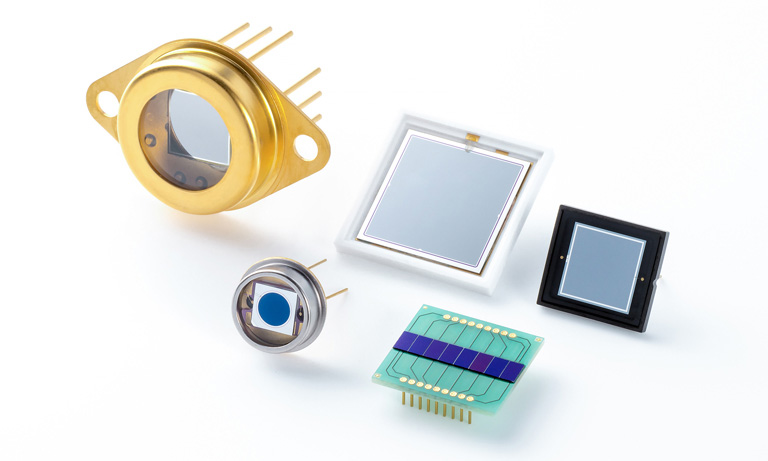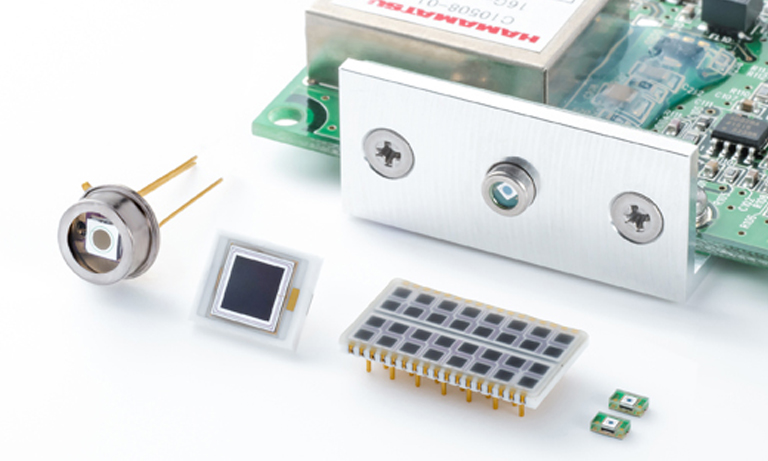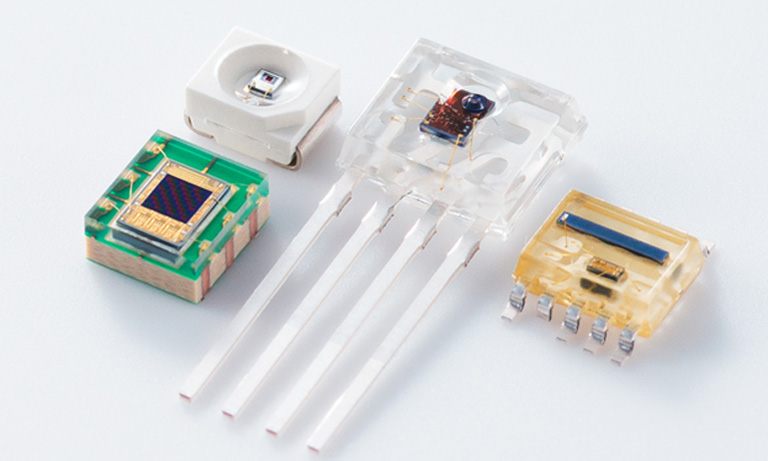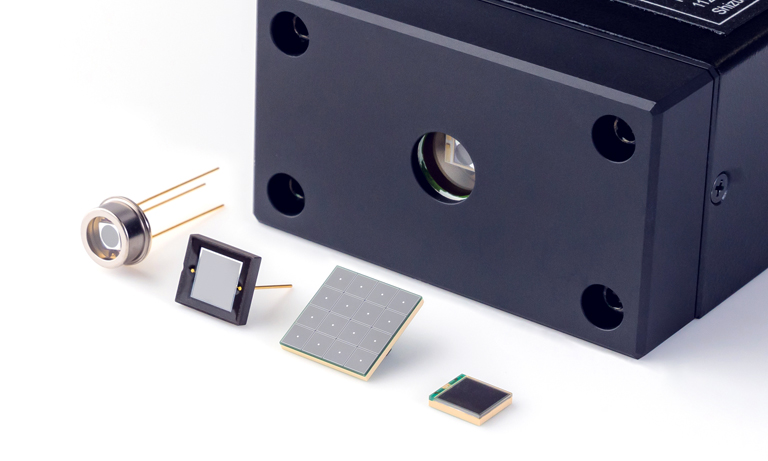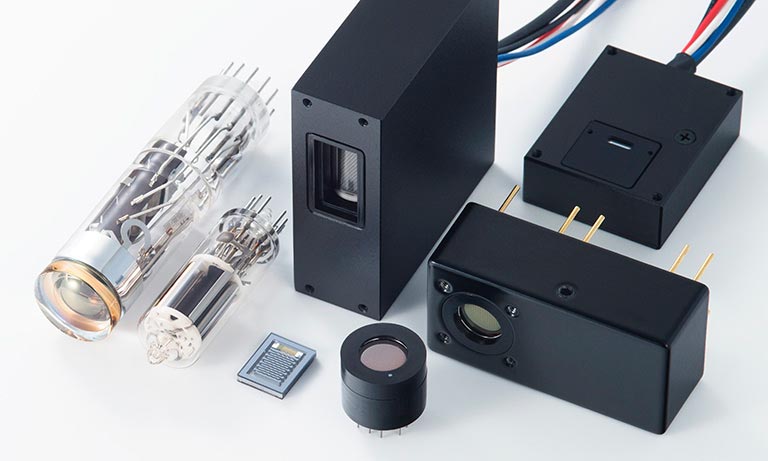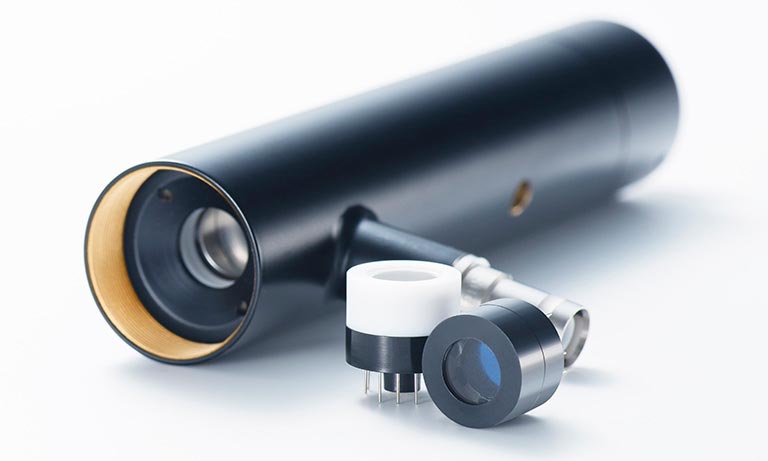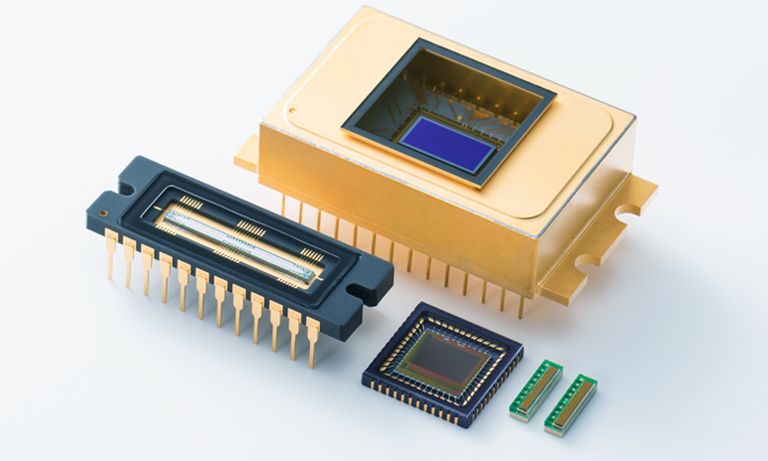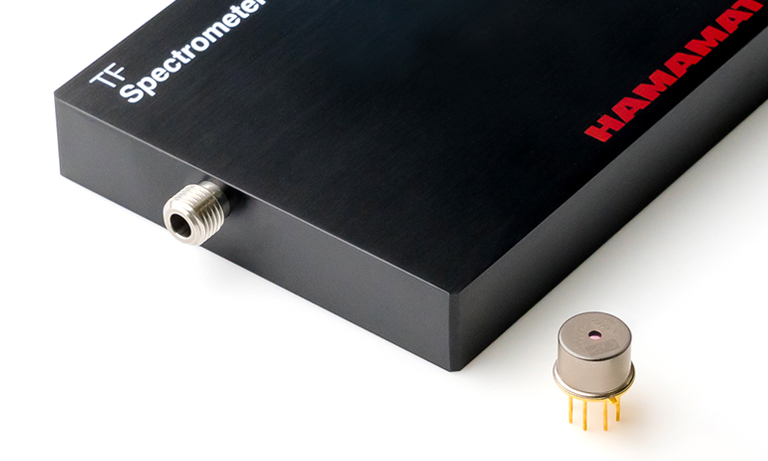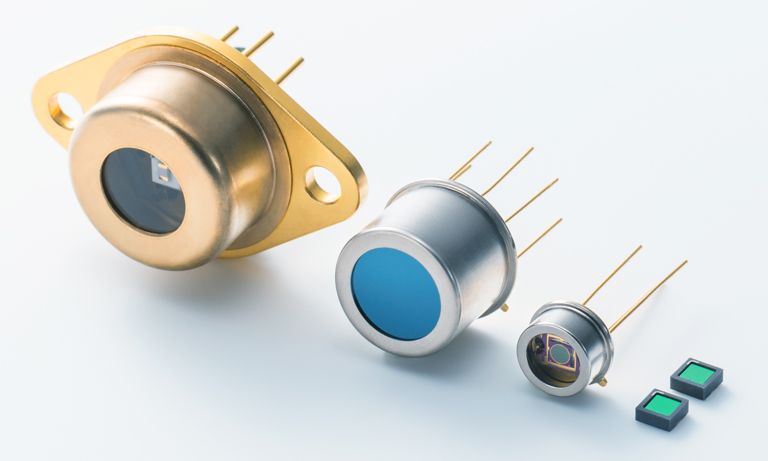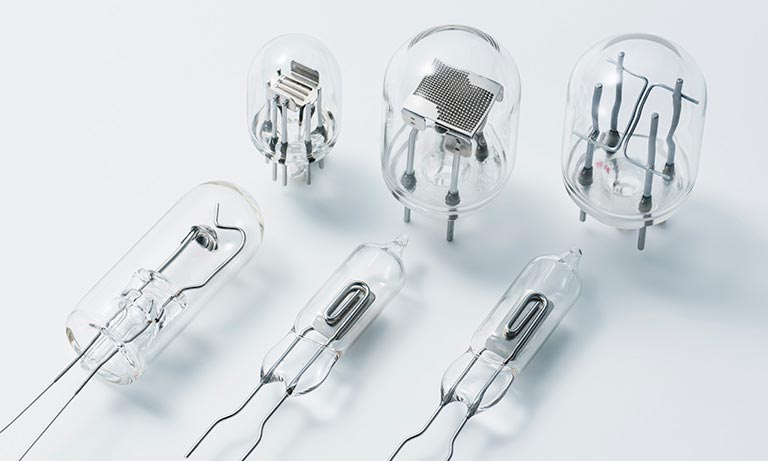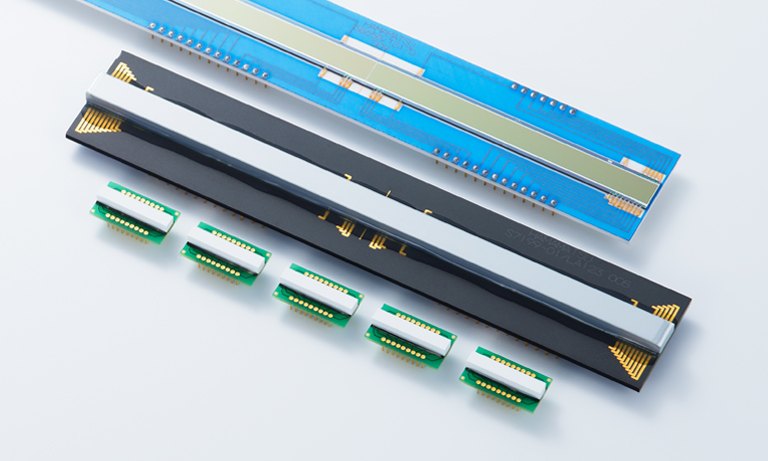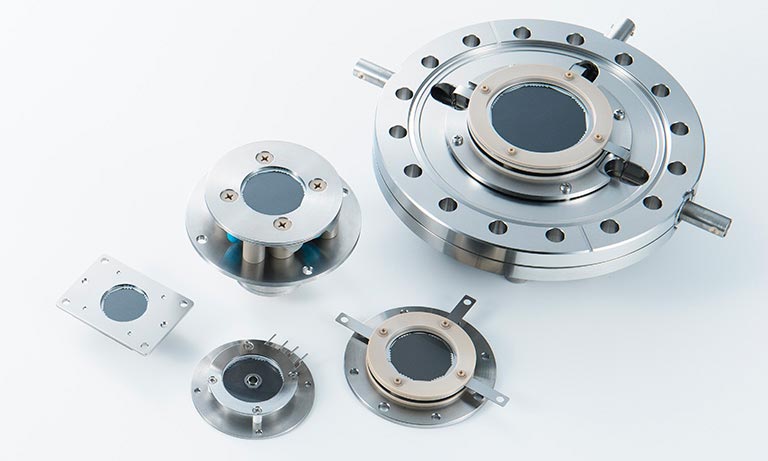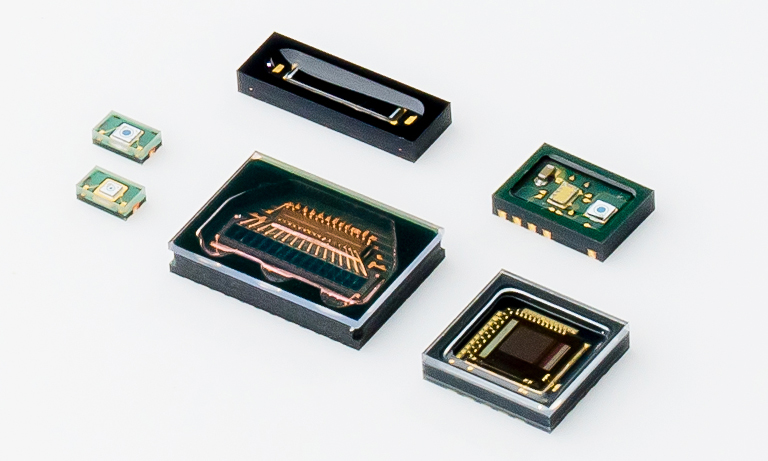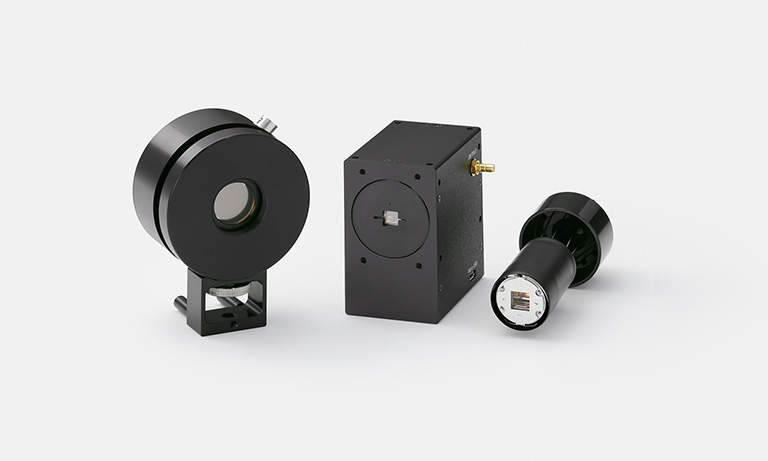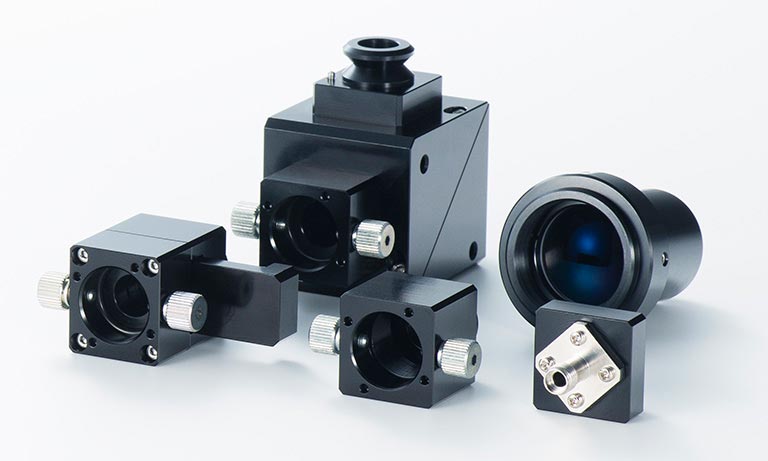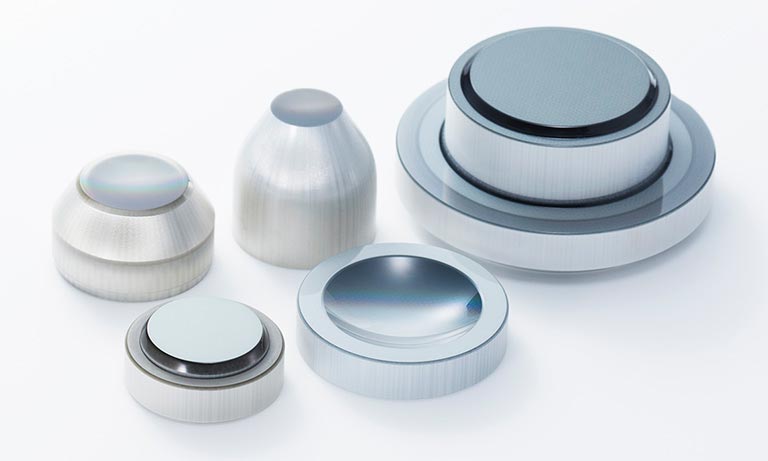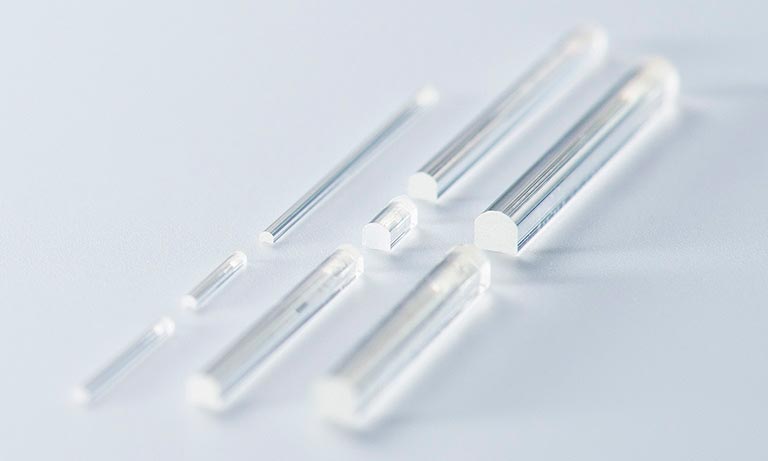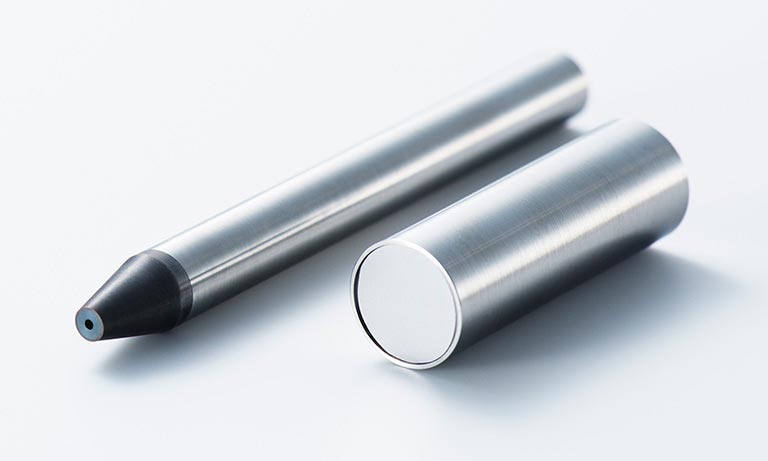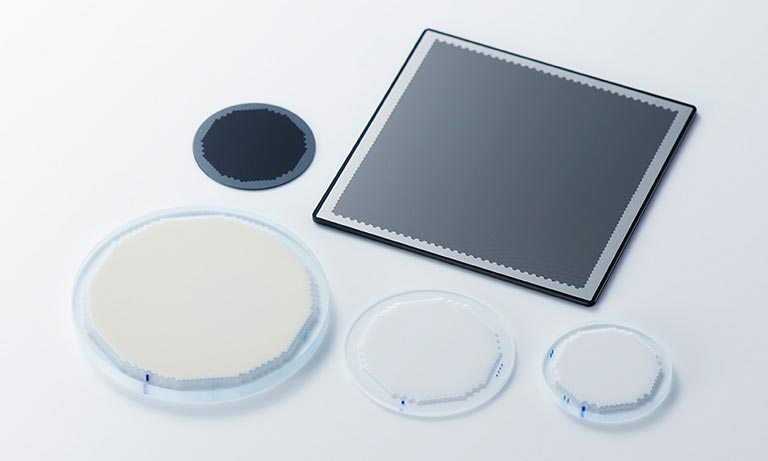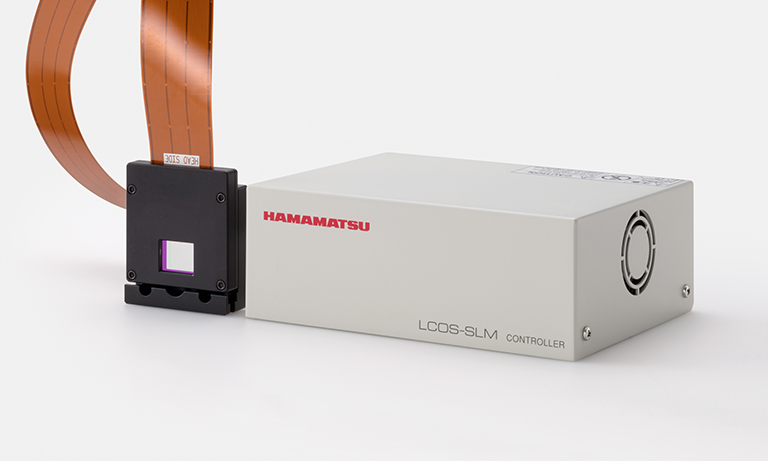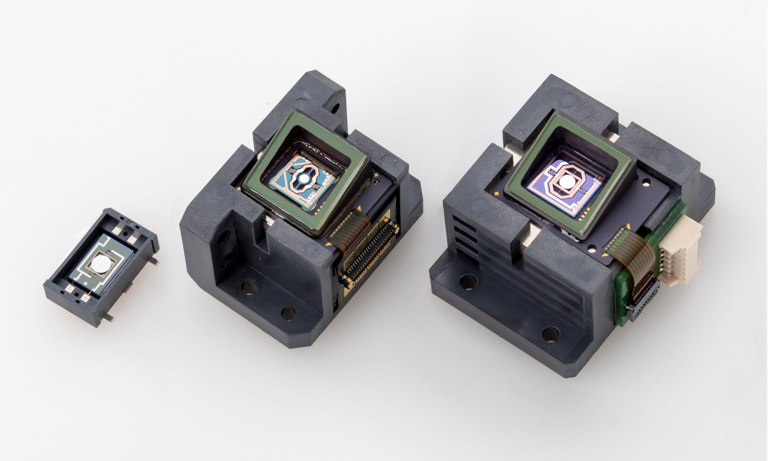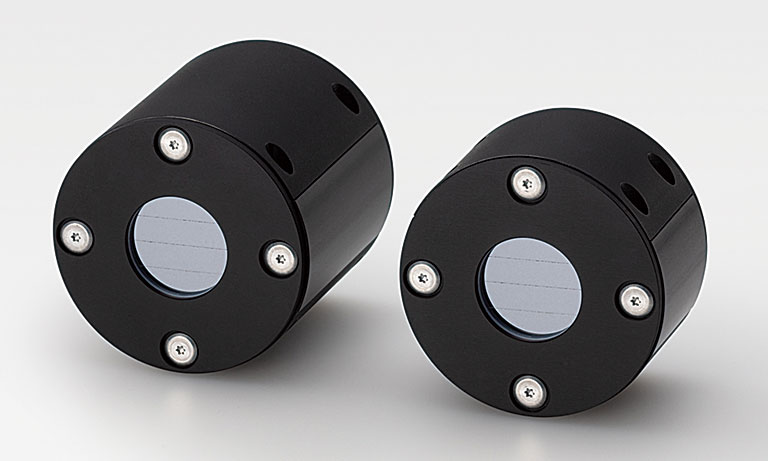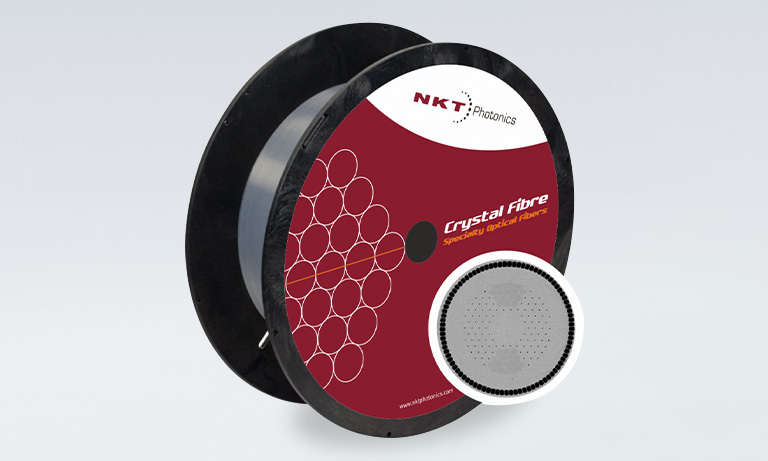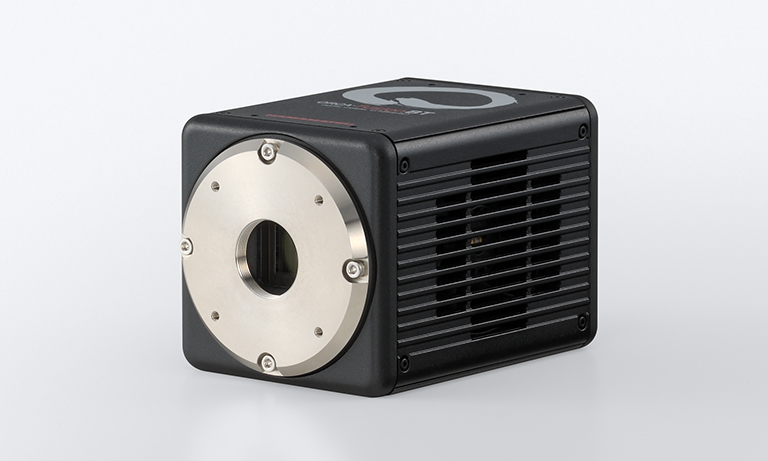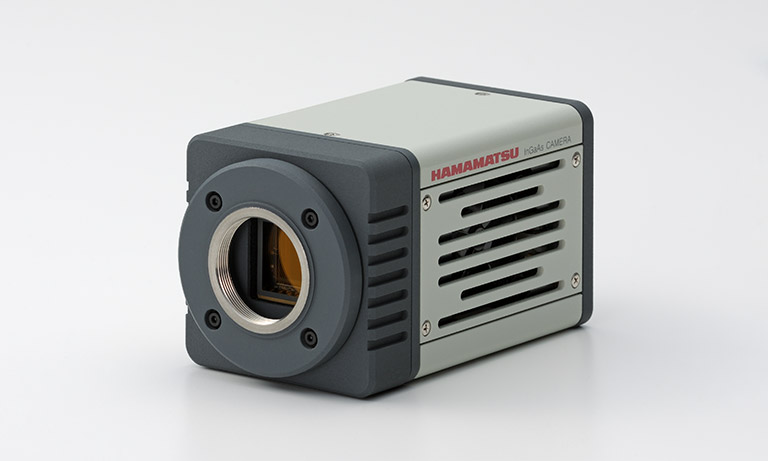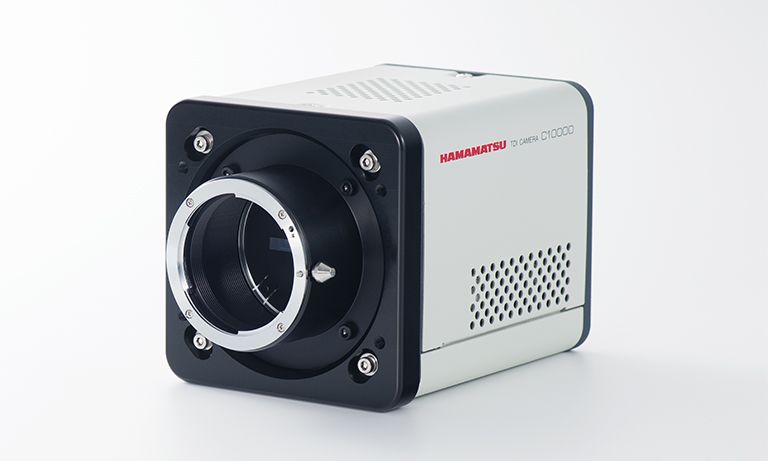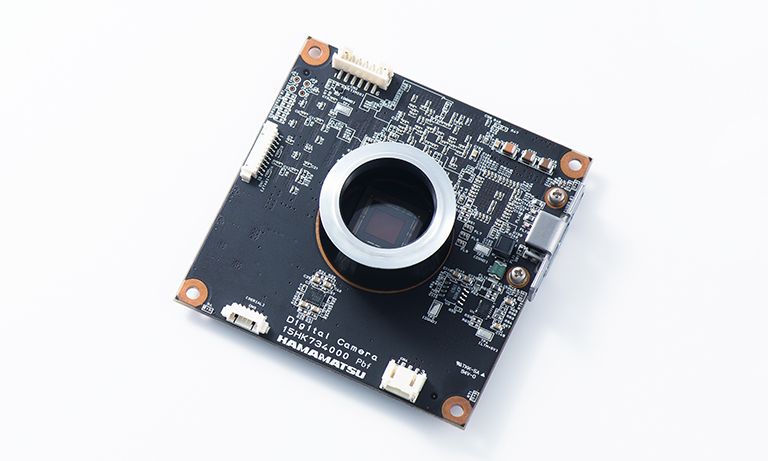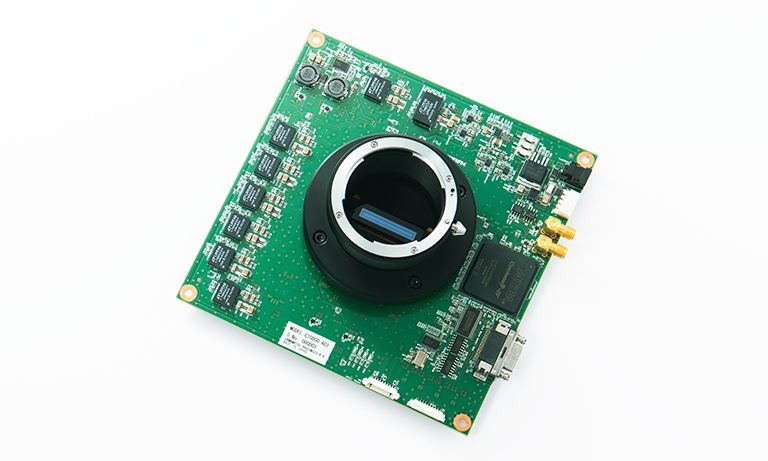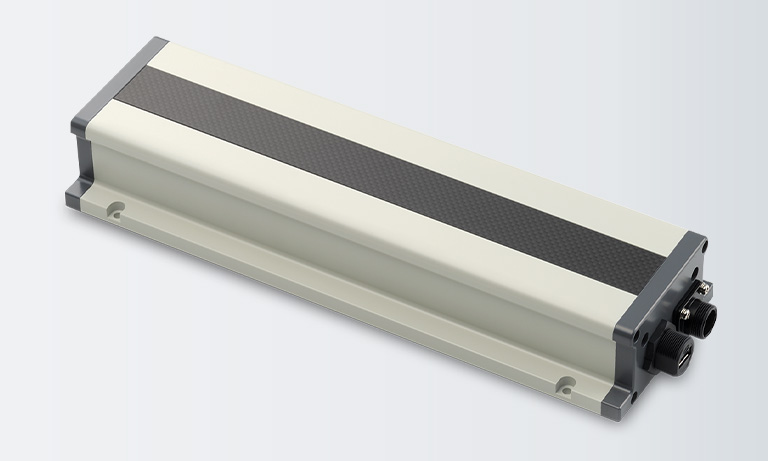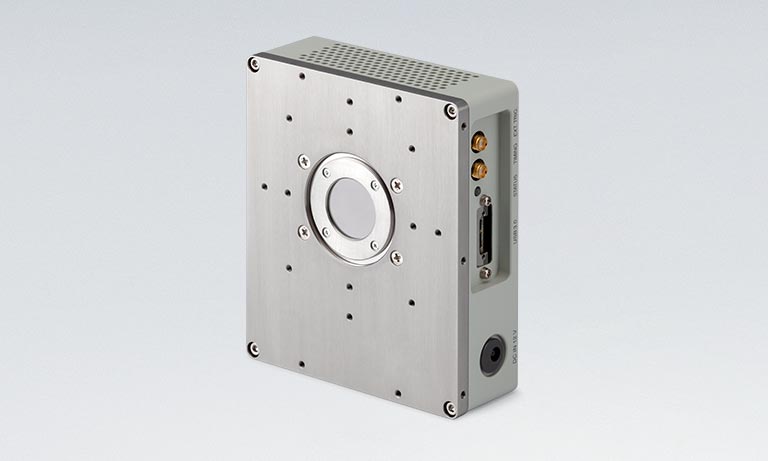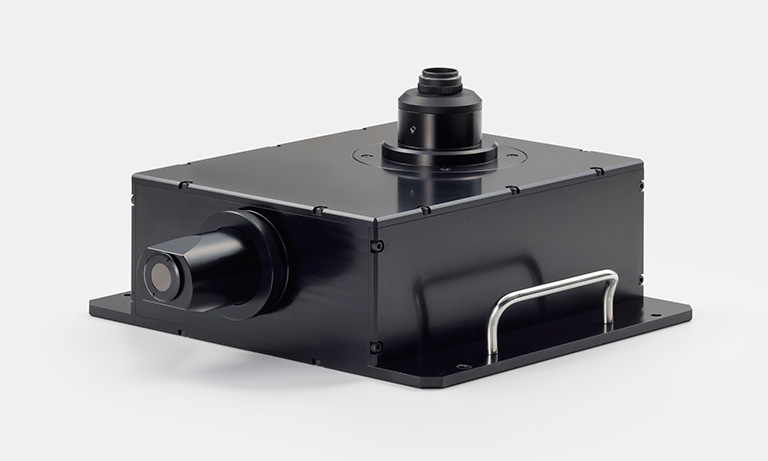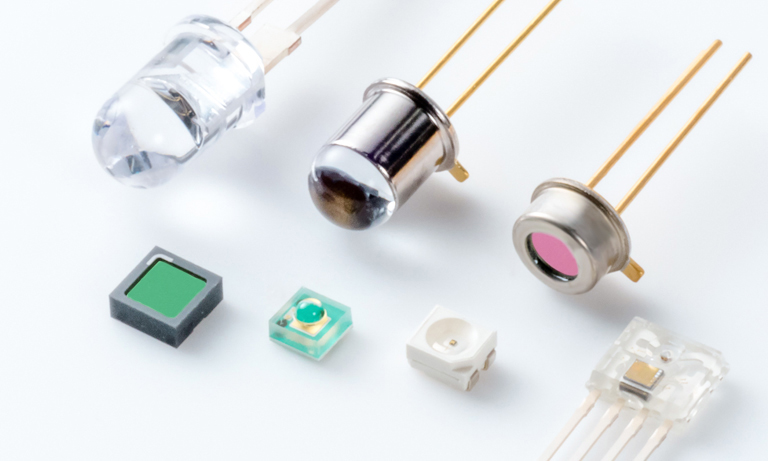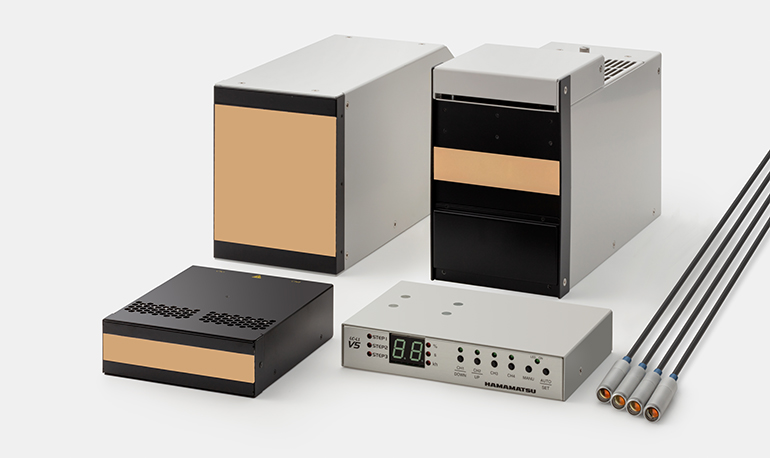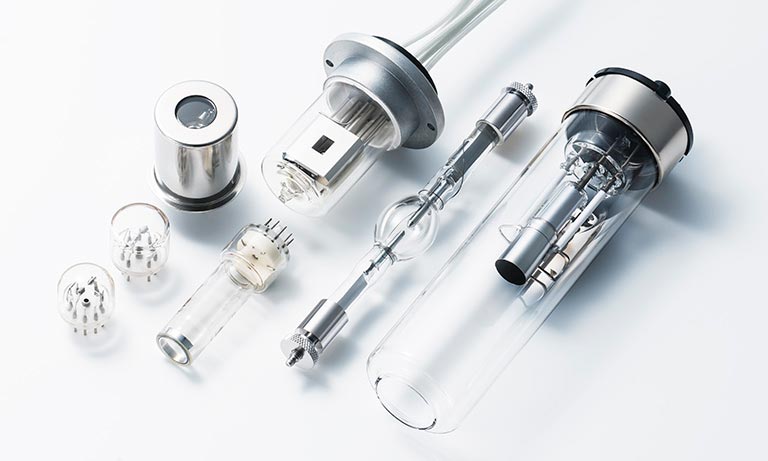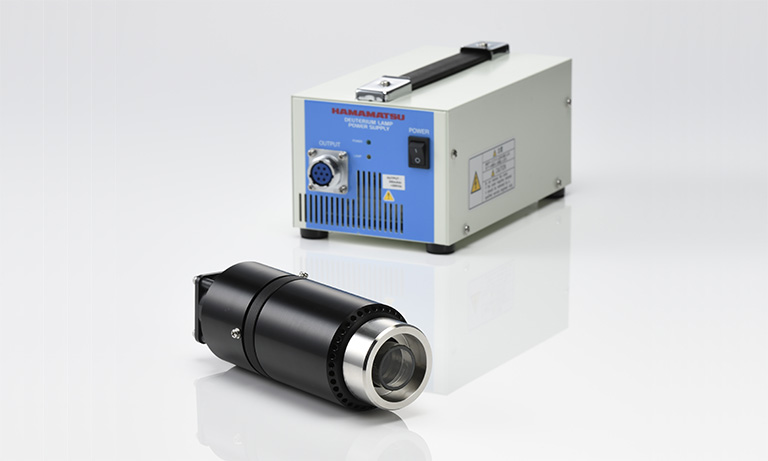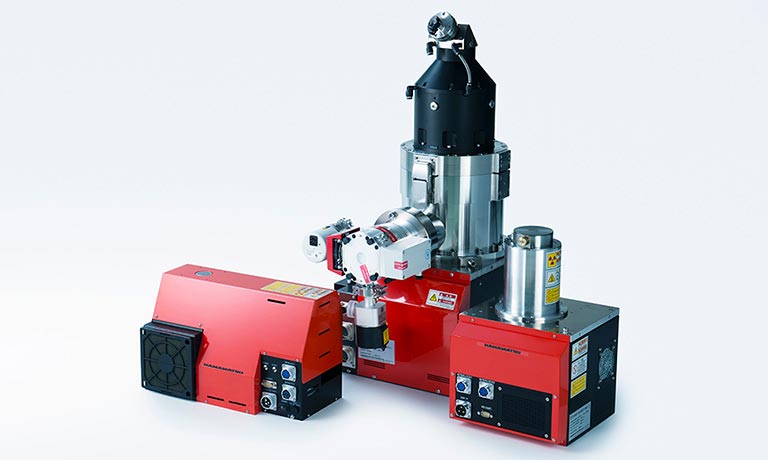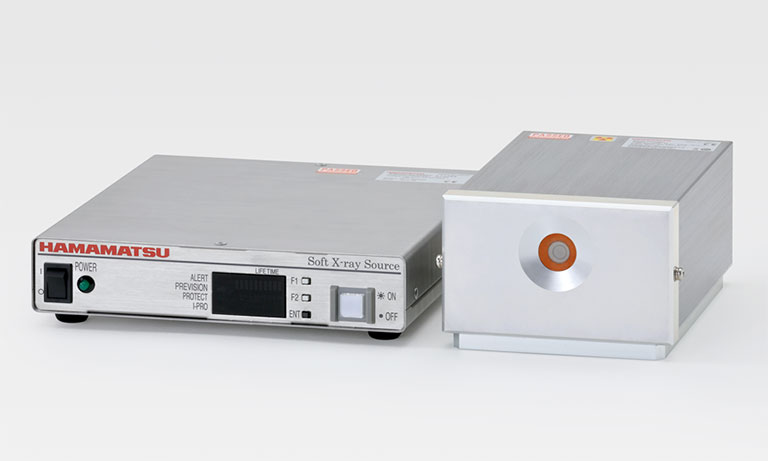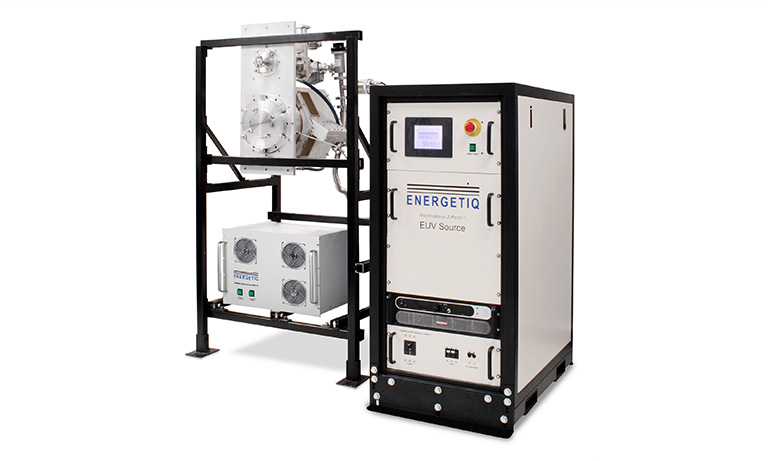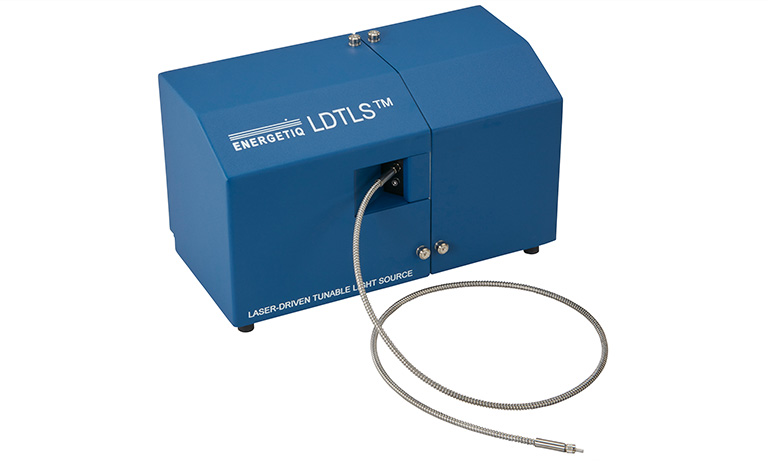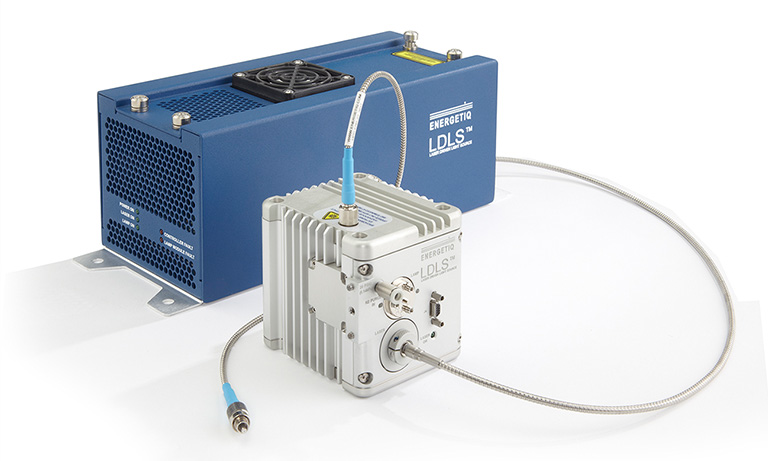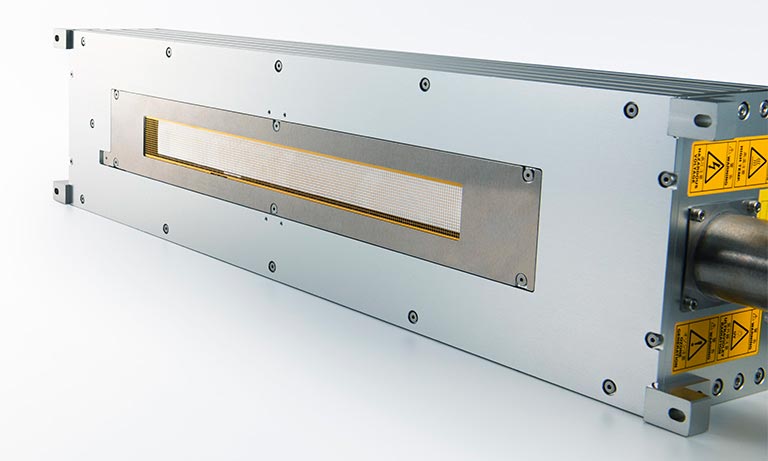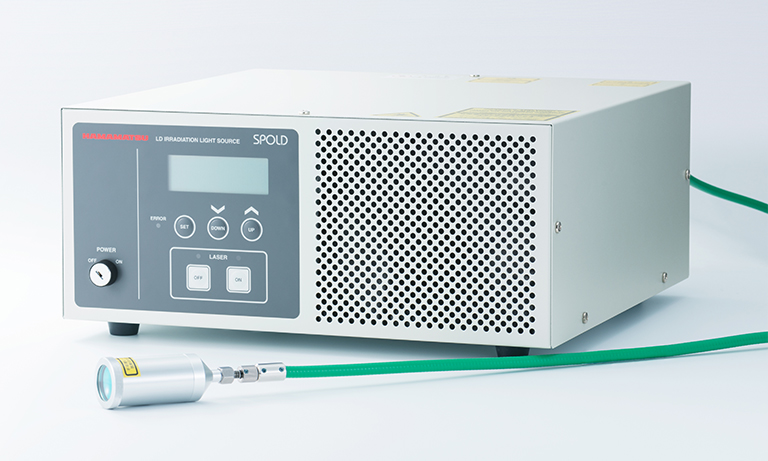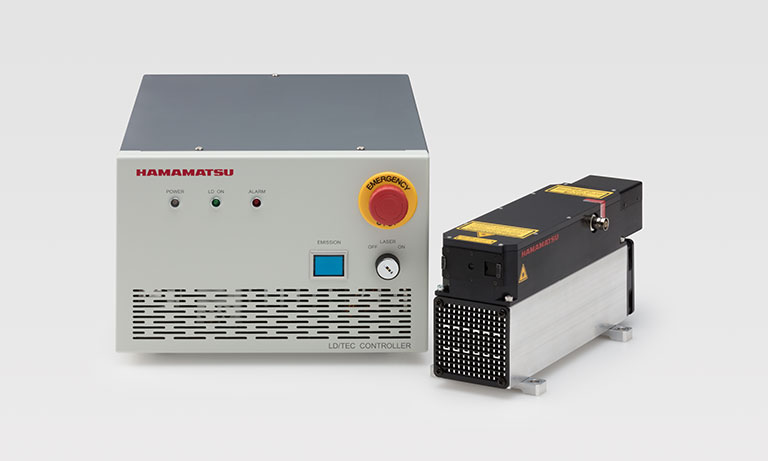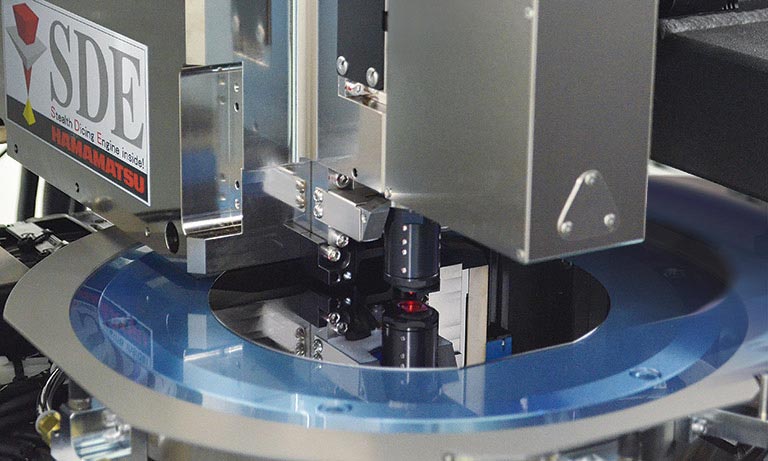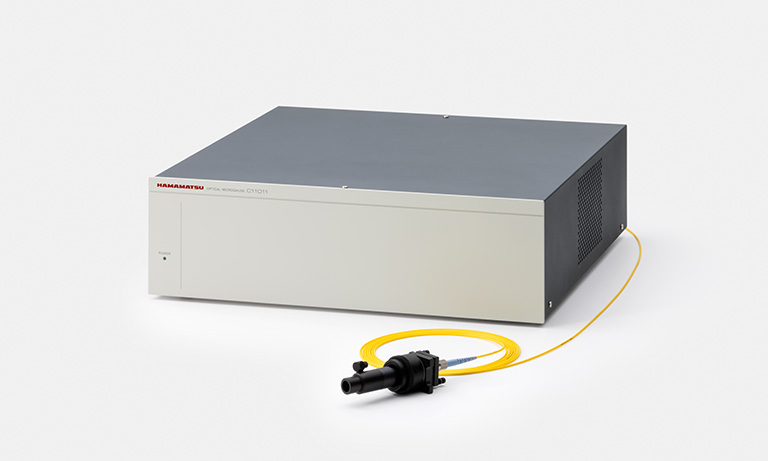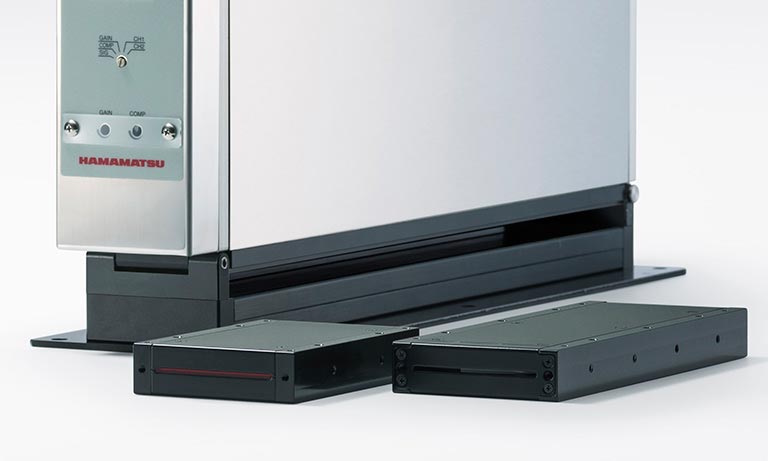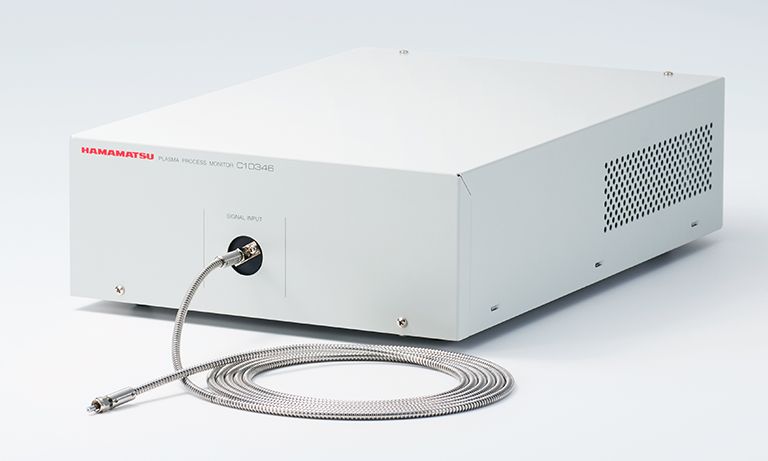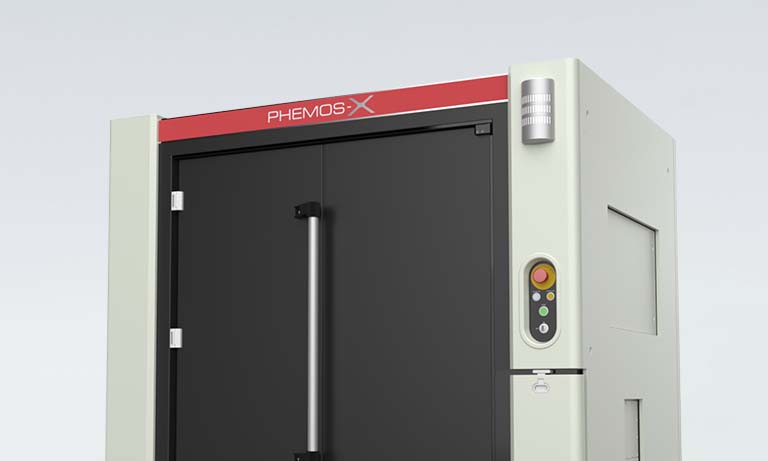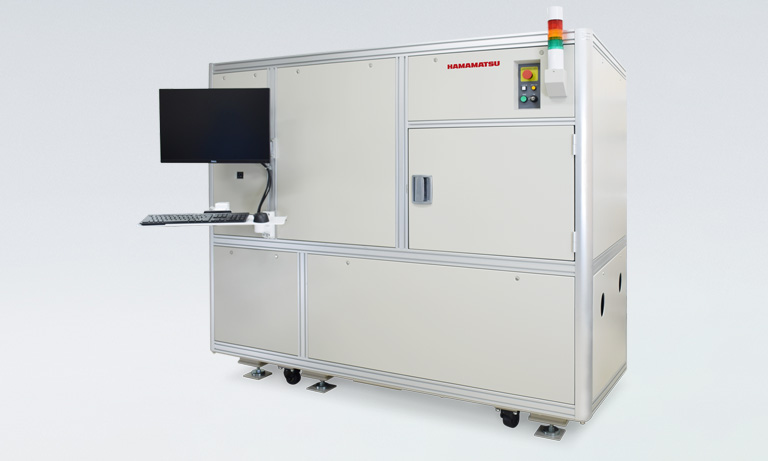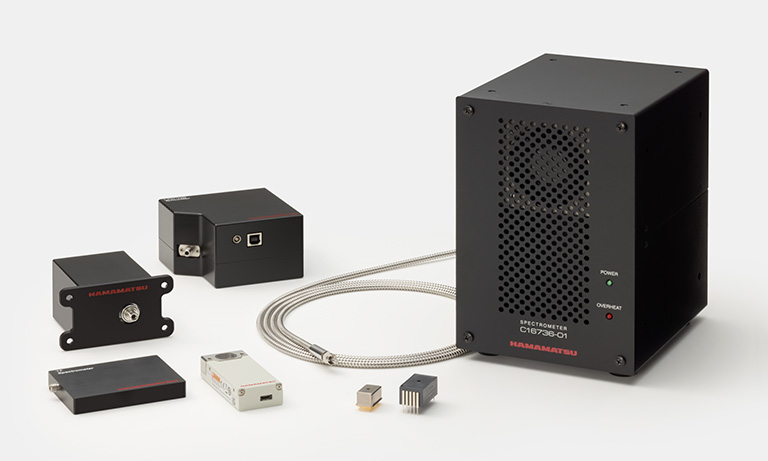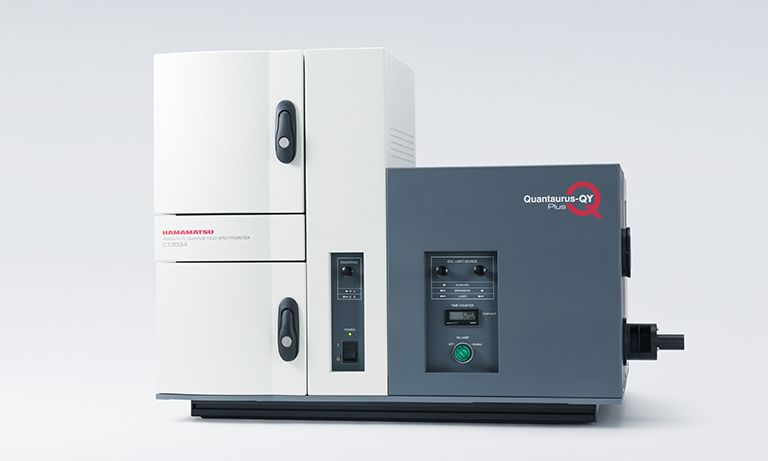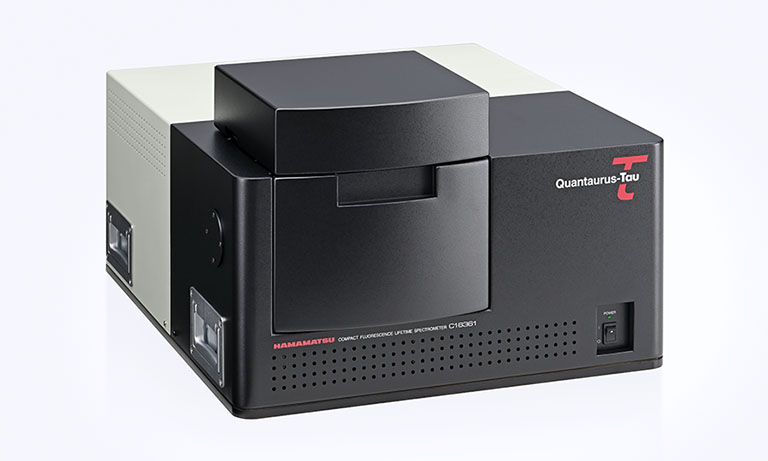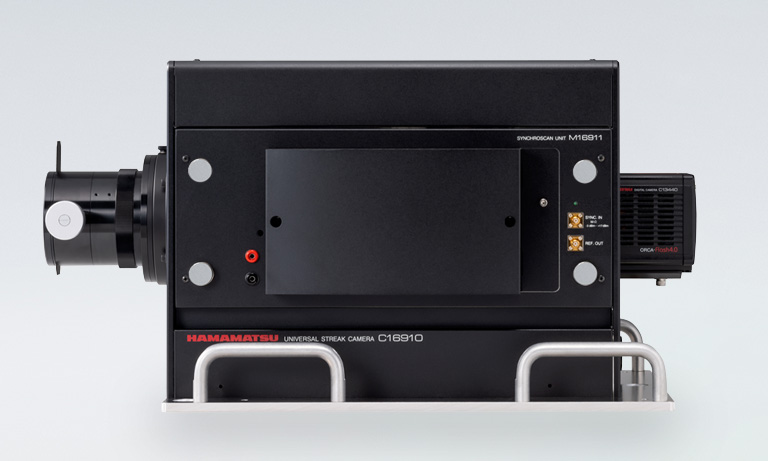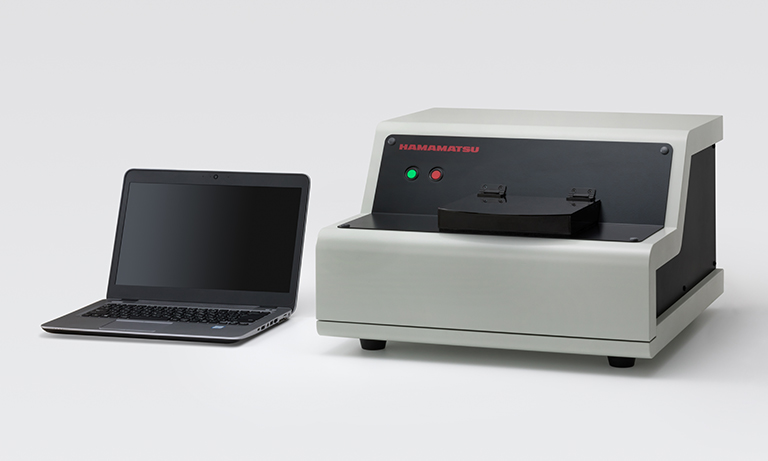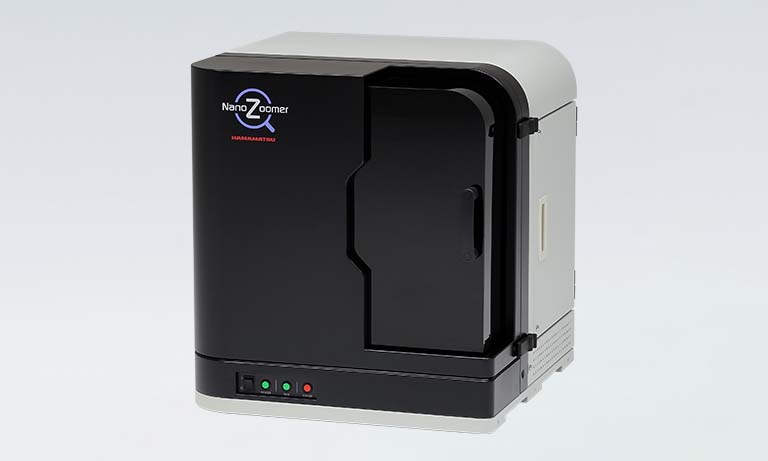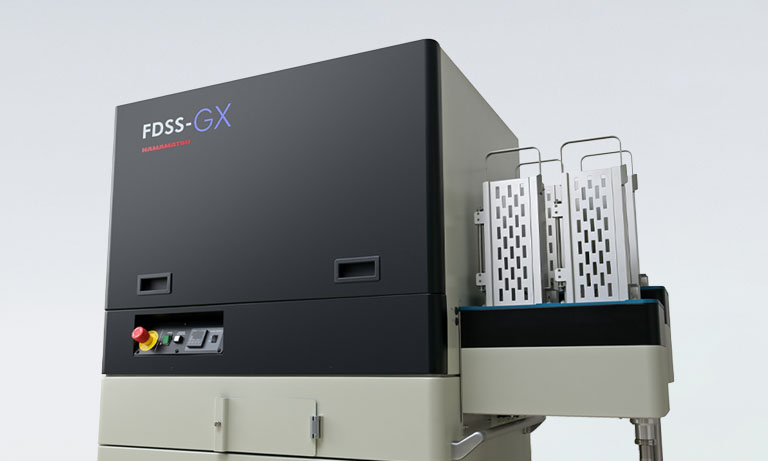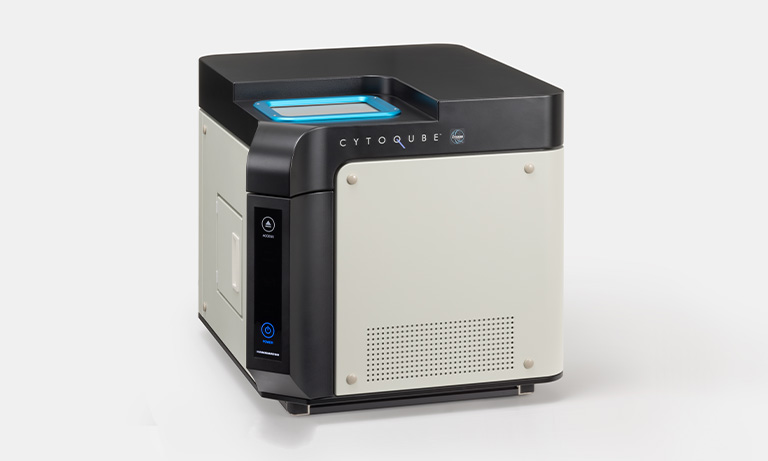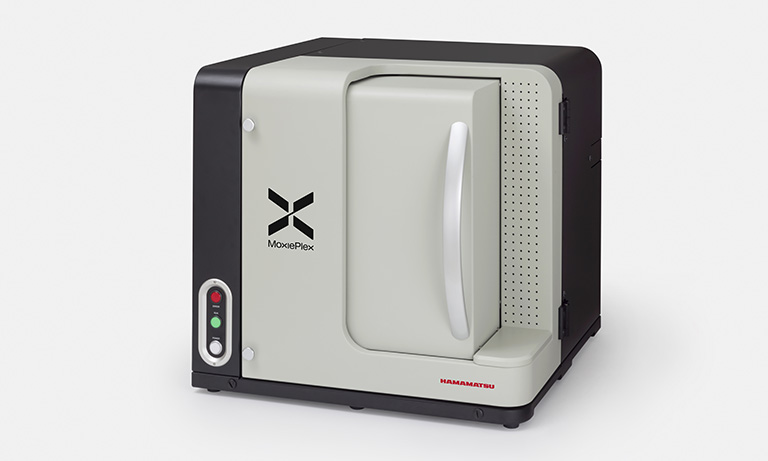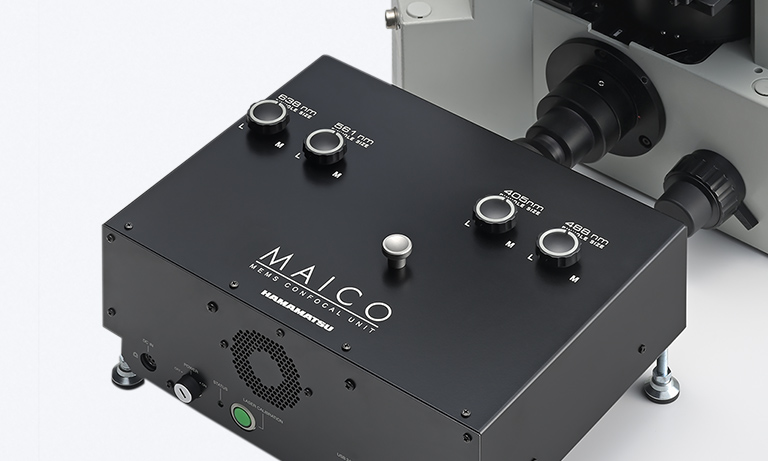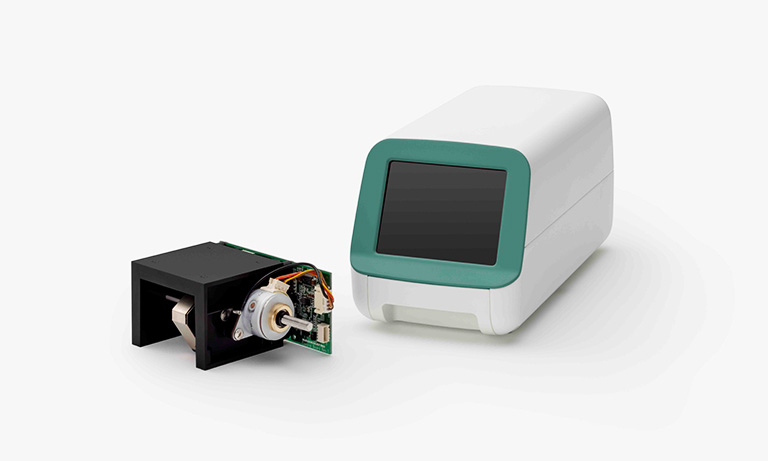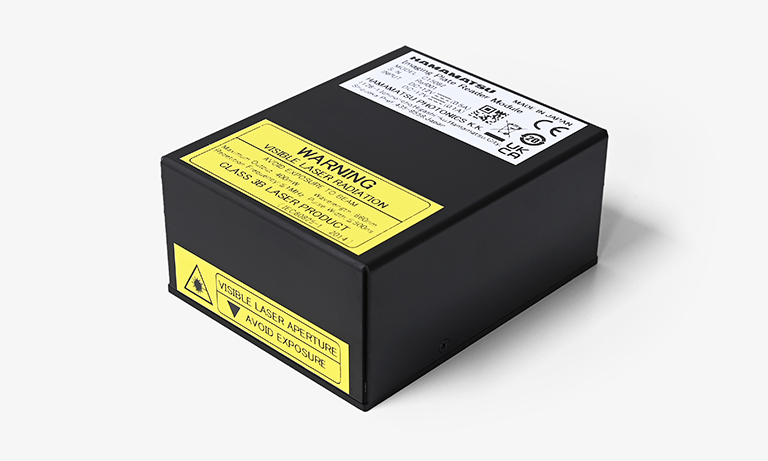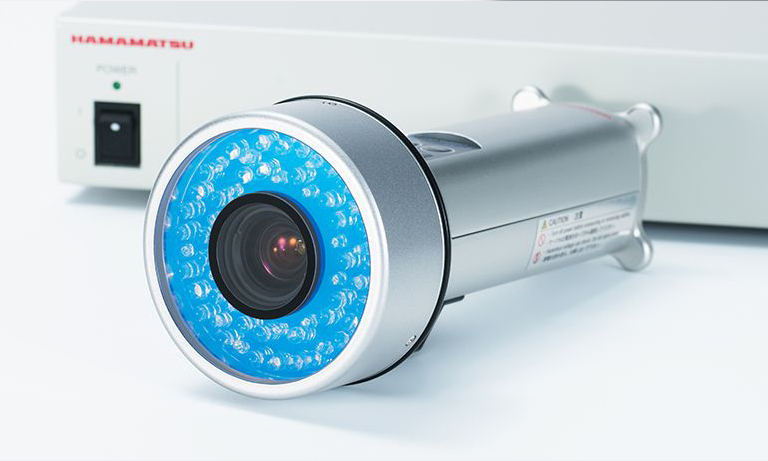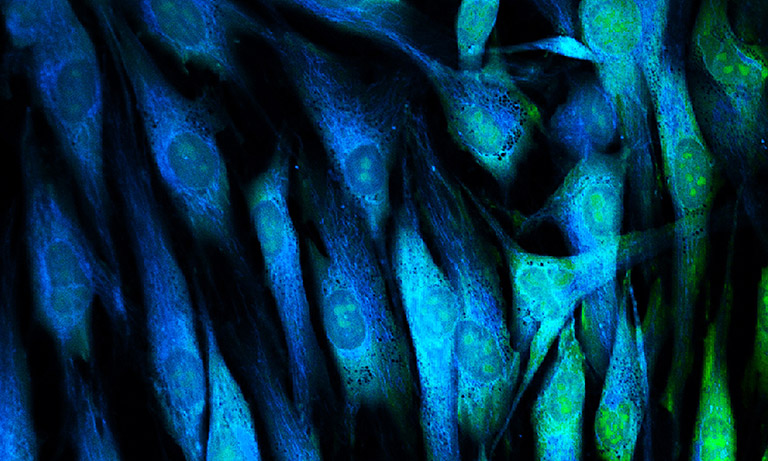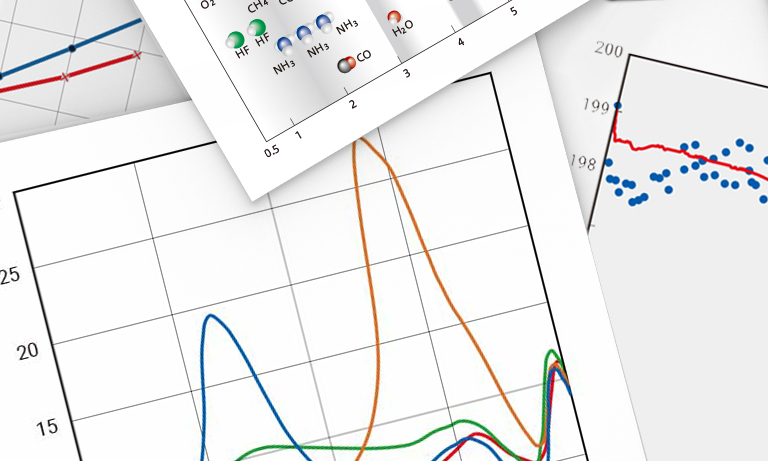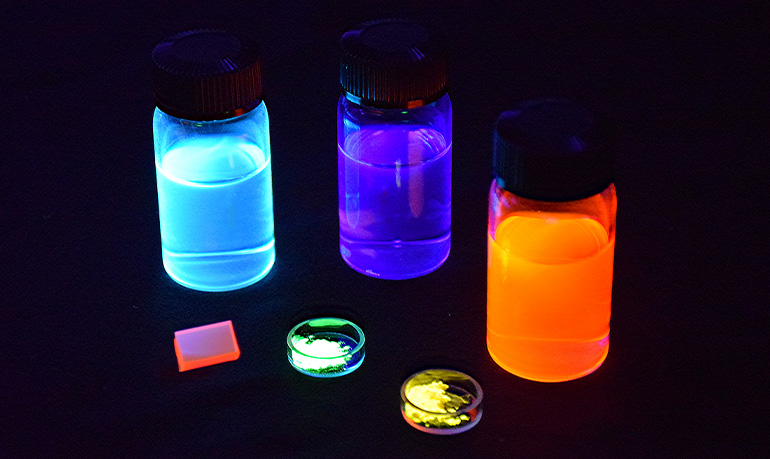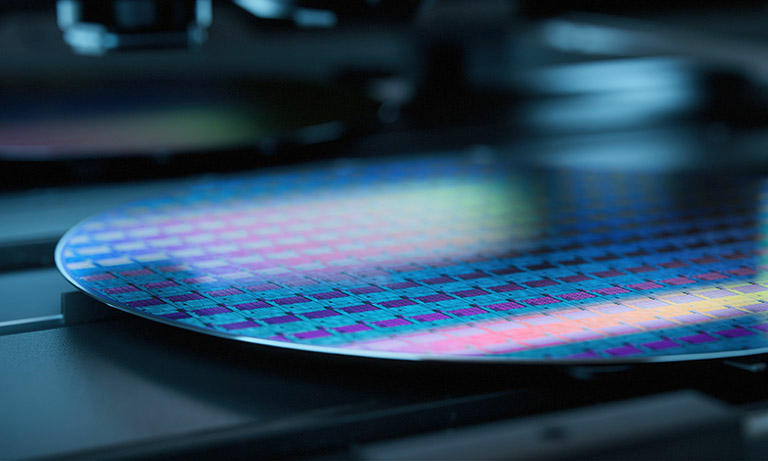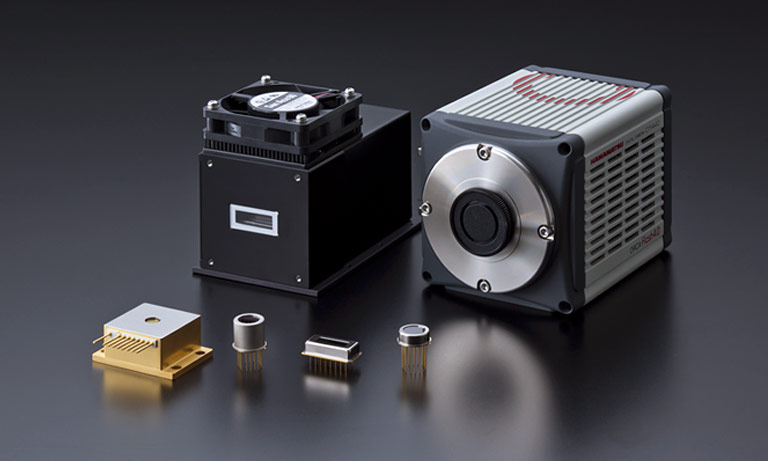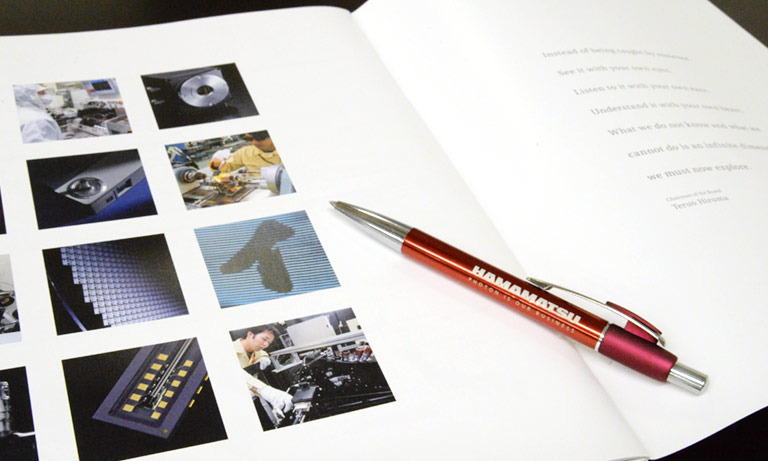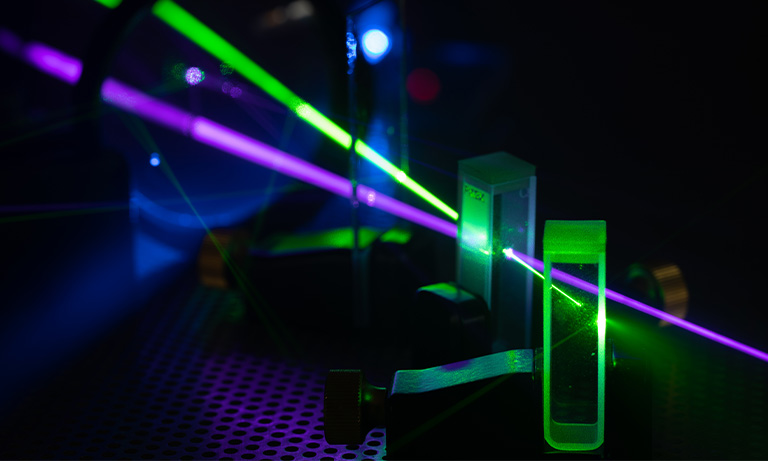Select your region or country.

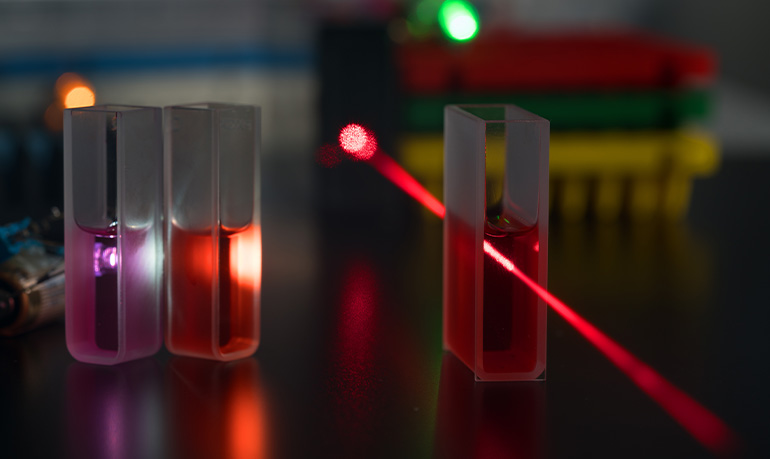
光致发光量子产率
什么是光致发光量子产率测量?
光致发光 (PL) 量子产率是指发光材料发射的发光光子数与吸收的激发态光子数之比。
PL 量子产率是指发光器件开发领域的一个重要指标,就降低器件用电功耗而言,提高发光效率至关重要。例如,在开发 OLED 显示器时,会利用 PL 量子产率测量评估材料性能,而精准计算 PL 量子产率则对器件研发至关重要。
PL 量子产率测量方法与原理
相对法与绝对法
测量发光量子产率的方法主要有两种:相对法与绝对法。
相对法是比较样品溶液的 PL 量子产率与在相同条件下测量的已知 PL 量子产率的标准溶液的 PL 量子产率。虽然该法仅需进行极少的校正(例如光谱灵敏度校正与溶剂折射率校正),但其无法精准测定量子产率,且操作过程耗时较长。此外,该法无法表征薄膜和粉末等固体样品。
绝对法无需标准样品即可测定 PL 量子产率。该法的主要技术为积分球法,其可测量薄膜和粉末等固体样品及溶液。该法可非常准确地测定量子产率,且更容易操作、耗时更少。
滨松光子学株式会社提供基于积分球法的紧凑型先进 PL 量子产率测量系统。
| 测量方法 | 需标准样品 | 可测量对象 |
|---|---|---|
| 相对法 | 必要 | 解决方案 |
| 绝对法(积分球法) | 非必要 | 溶液、固体(薄膜、粉末等) |
什么是积分球?
积分球是指一种由空心球体组成的光学组件,其内表面涂有高反射高扩散物质。发光材料与器件常呈现出独特的光分布角度特性,导致测量辉度随测量位置而变化。当光射入积分球或由积分球内放置的样品发出时,光会在积分球内壁发生多次漫反射。该过程使球内光分布均匀,无论从哪个方向测量,辐射度都近乎一致。积分球内的均匀光分布与发光材料或器件发出的总辐射通量成正比。
利用积分球法,可以准确测量 PL 量子产率,且不受发光材料各向异性光分布特性的影响。该法确保测量能真实反映样品的本征发射特性,从而提供可靠且可重复的测量结果。

图1:发光材料发光图像
PL 量子产率测量原理
图2展示了使用积分球的绝对 PL 量子产率测量系统的示例。该系统一般由激发光源、积分球、光谱仪和数据分析仪组成。将待测量样品放在积分球内的样品架上。从激发光源输出的激发光经光导引入积分球内并辐射到样品上。激发光与样品发出的光于积分球内发生漫反射,进而产生均匀的辉度。可通过光谱仪的光纤探头测量其中的一部分光。
图3展示了 PL 量子产率测量的原理。测量 PL 量子产率时,需要测量参照物与样品的激发光谱和发射光谱。按照从参照物到样品的顺序测量。开始测量参照物时,仅在样品架中进行测量,不测量样品。图 3 中,相比参考光谱,样品光谱的激发光强有所下降,但在较长波长处可观察到发光。这表明样品吸收了部分激发光并发出光。可根据参照物与样品的激发光积分强度与样品较长波长处的发光积分强度之间的差计算 PL 量子产率。

图2:带积分球的绝对 PL 量子产率测量系统示例

图3:PL 量子产率测量原理
PL 量子产率测量示例
高光效热活化延迟荧光材料的量子产率测量
热活化延迟荧光 (TADF) 材料是众所周知的第三代 OLED 材料。TADF 是由最低三线态反向系间窜跃 (RISC) 至单线态时产生的荧光。最低激发态之间的小能隙 (ΔEST) 促进了 RISC 过程。通过精准的分子设计成功研发出一种新型 TADF 材料 (4CzIPN)。该材料的 ΔEST 较小,且显示出 0.94 +/- 0.02 的高 PL 量子产率。

Data courtesy of Prof. Chihaya Adachi, Hajime Nakanotani
Center for Organic Photonics and Electronics Research, Kyushu Univ.
H. Uoyama, K. Goushi, K. Shizu, H. Nomura, and C. Adachi, Nature. 492, 234 (2012).
蒽溶液的荧光光谱与荧光量子产率
使用我们的绝对 PL 量子产率测量系统测量标准荧光溶液的量子产率。使用标准荧光溶液,以相对法测量 PL 量子产率。对于大多数化合物,我们的系统测得的量子产率与文献报道值高度吻合,充分证明了我们的系统的高可靠性。

Collaborative research of Hamamatsu Photonics K.K.; A. Kobayashi, S. Kaneko, K. Takehira, T. Yoshihara, and S. Tobita, Faculty of Engineering, Gunma University; H.Ishida, Y.Shiina, and S.Oishi, School of Science, Kitasato University
K. Suzuki, A. Kobayashi, S. Kaneko, K. Takehira, T. Yoshihara, H. Ishida, Y. Shiina, S. Oishi, and S. Tobita, Phys. Chem. Chem. Phys., 11, 9850 (2009).
对三联苯和蒽单晶体的荧光量子产率与研磨效应
我们利用对三联苯和蒽的高纯度单晶体,测定这两种典型有机材料各自的荧光量子产率。测量对三联苯,结果显示该高纯度单晶体的荧光量子产率为0.67(图A中的蓝色曲线)。将该单晶体研磨成细粉,使其荧光量子产率升至0.80(图A中的红色曲线)。再研磨高纯度单晶体蒽,使其荧光量子产率从0.64降至0.27(图B)。测量对三联苯,结果显示出高荧光量子产率及荧光光谱短波长侧的结构外观。因此,高荧光量子产率可能是由研磨产生的细粉所引起的,因为这些细粉抑制了再吸收。对蒽进行检测发现,除荧光光谱短波长处的常见发光组分外,研磨还导致长波长处出现发光组分。短波长的发光组分与蒽二聚体的荧光光谱特征相符,因此被认定为来自二聚体态的发光。这证明蒽单晶体荧光量子产率的下降是由研磨诱导产生的二聚体造成的,这些二聚体导致了结构缺陷,并充当了消光中心。


Collaborative research of Hamamatsu Photonics K.K.; Ryuzi Katoh, Akihiro Furube, Ph.D., Research Institute of Instrumentation Frontier, Advanced Industrial Science and Technology; Masahiro Kotani, Ph.D., Department of Chemistry, Gakushuin University; and Katsumi Tokumaru, University of Tsukuba.
R. Katoh, K. Suzuki, A. Furube, M. Kotani, and K. Tokumaru, J. Phys. Chem. C, 113, 2961(2009).
−196 ˚C (77K) 下二苯甲酮的磷光量子产率测量
在室温 (22 ˚C (295 K)) 和低温 (-196 ˚C (77 K)) 下分别测量了二苯甲酮有机溶液的磷光量子产率,并在图中对二者进行了比较。已知二苯甲酮被光激发后从基态跃迁至单线态,能高效(fISC 至 1.0)生成三线态激发态。鉴于磷光属于禁阻跃迁,通常很难观测到普通有机化合物的磷光。尽管二苯甲酮中的磷光微弱,但仍明确观测到了磷光光谱(fP 至 0.01)。此外,结果还表明,相比室温,低温下的磷光强度显著增加,且其磷光量子产率更高 (fP>0.8)。

Collaborative research of Hamamatsu Photonics K.K.; A. Kobayashi, S. Kaneko, K. Takehira, T. Yoshihara, and S. Tobita, Faculty of Engineering, Gunma University
A. Kobayashi, K. Suzuki, T. Yoshihara, and S. Tobita, Chem. Lett., 39, 282 (2010).
特色产品与系统/仪器
具有易扩展功能的绝对 PL 量子产率测量系统。通过添加选件支持近红外测量、高灵敏度(低量子产率)测量及上转换发光测量。
Quantaurus-QY 操作说明
Quantaurus-QY 是一款紧凑型仪器,它将激发光源、探测器和光学系统集成到一个设备中,无需研究人员像以前一样花费大量时间和精力调整多个组件,即可进行测量。只需装载样品并给出一些指令,即可在短时间内测量发光量子产率、激发波长依赖性、PL 激发光谱等。
案例研究
为评估Center for Organic Photonics and Electronics Research (OPERA), Kyushu University 正在研发的有机光电材料和器件,需用到各种测量方法,如光致发光 (PL) 量子产率测量和荧光寿命测量。为进行此类评估,我们推出了Quantaurus系列与条纹相机。
我们采访了Prof. Chihaya Adachi, Director of the Center与 Assoc. Prof. Hajime Nakanotani,主题为绝对光致发光量子产率测量方法的确立、我们的Quantaurus系列对其研究的影响以及其对未来研究的展望。
其他测量方法
- Confirmation
-
It looks like you're in the . If this is not your location, please select the correct region or country below.
You're headed to Hamamatsu Photonics website for (Chinese). If you want to view an other country's site, the optimized information will be provided by selecting options below.
In order to use this website comfortably, we use cookies. For cookie details please see our cookie policy.
- Cookie Policy
-
This website or its third-party tools use cookies, which are necessary to its functioning and required to achieve the purposes illustrated in this cookie policy. By closing the cookie warning banner, scrolling the page, clicking a link or continuing to browse otherwise, you agree to the use of cookies.
Hamamatsu uses cookies in order to enhance your experience on our website and ensure that our website functions.
You can visit this page at any time to learn more about cookies, get the most up to date information on how we use cookies and manage your cookie settings. We will not use cookies for any purpose other than the ones stated, but please note that we reserve the right to update our cookies.
1. What are cookies?
For modern websites to work according to visitor’s expectations, they need to collect certain basic information about visitors. To do this, a site will create small text files which are placed on visitor’s devices (computer or mobile) - these files are known as cookies when you access a website. Cookies are used in order to make websites function and work efficiently. Cookies are uniquely assigned to each visitor and can only be read by a web server in the domain that issued the cookie to the visitor. Cookies cannot be used to run programs or deliver viruses to a visitor’s device.
Cookies do various jobs which make the visitor’s experience of the internet much smoother and more interactive. For instance, cookies are used to remember the visitor’s preferences on sites they visit often, to remember language preference and to help navigate between pages more efficiently. Much, though not all, of the data collected is anonymous, though some of it is designed to detect browsing patterns and approximate geographical location to improve the visitor experience.
Certain type of cookies may require the data subject’s consent before storing them on the computer.
2. What are the different types of cookies?
This website uses two types of cookies:
- First party cookies. For our website, the first party cookies are controlled and maintained by Hamamatsu. No other parties have access to these cookies.
- Third party cookies. These cookies are implemented by organizations outside Hamamatsu. We do not have access to the data in these cookies, but we use these cookies to improve the overall website experience.
3. How do we use cookies?
This website uses cookies for following purposes:
- Certain cookies are necessary for our website to function. These are strictly necessary cookies and are required to enable website access, support navigation or provide relevant content. These cookies direct you to the correct region or country, and support security and ecommerce. Strictly necessary cookies also enforce your privacy preferences. Without these strictly necessary cookies, much of our website will not function.
- Analytics cookies are used to track website usage. This data enables us to improve our website usability, performance and website administration. In our analytics cookies, we do not store any personal identifying information.
- Functionality cookies. These are used to recognize you when you return to our website. This enables us to personalize our content for you, greet you by name and remember your preferences (for example, your choice of language or region).
- These cookies record your visit to our website, the pages you have visited and the links you have followed. We will use this information to make our website and the advertising displayed on it more relevant to your interests. We may also share this information with third parties for this purpose.
Cookies help us help you. Through the use of cookies, we learn what is important to our visitors and we develop and enhance website content and functionality to support your experience. Much of our website can be accessed if cookies are disabled, however certain website functions may not work. And, we believe your current and future visits will be enhanced if cookies are enabled.
4. Which cookies do we use?
There are two ways to manage cookie preferences.
- You can set your cookie preferences on your device or in your browser.
- You can set your cookie preferences at the website level.
If you don’t want to receive cookies, you can modify your browser so that it notifies you when cookies are sent to it or you can refuse cookies altogether. You can also delete cookies that have already been set.
If you wish to restrict or block web browser cookies which are set on your device then you can do this through your browser settings; the Help function within your browser should tell you how. Alternatively, you may wish to visit www.aboutcookies.org, which contains comprehensive information on how to do this on a wide variety of desktop browsers.
5. What are Internet tags and how do we use them with cookies?
Occasionally, we may use internet tags (also known as action tags, single-pixel GIFs, clear GIFs, invisible GIFs and 1-by-1 GIFs) at this site and may deploy these tags/cookies through a third-party advertising partner or a web analytical service partner which may be located and store the respective information (including your IP-address) in a foreign country. These tags/cookies are placed on both online advertisements that bring users to this site and on different pages of this site. We use this technology to measure the visitors' responses to our sites and the effectiveness of our advertising campaigns (including how many times a page is opened and which information is consulted) as well as to evaluate your use of this website. The third-party partner or the web analytical service partner may be able to collect data about visitors to our and other sites because of these internet tags/cookies, may compose reports regarding the website’s activity for us and may provide further services which are related to the use of the website and the internet. They may provide such information to other parties if there is a legal requirement that they do so, or if they hire the other parties to process information on their behalf.
If you would like more information about web tags and cookies associated with on-line advertising or to opt-out of third-party collection of this information, please visit the Network Advertising Initiative website http://www.networkadvertising.org.
6. Analytics and Advertisement Cookies
We use third-party cookies (such as Google Analytics) to track visitors on our website, to get reports about how visitors use the website and to inform, optimize and serve ads based on someone's past visits to our website.
You may opt-out of Google Analytics cookies by the websites provided by Google:
https://tools.google.com/dlpage/gaoptout?hl=en
As provided in this Privacy Policy (Article 5), you can learn more about opt-out cookies by the website provided by Network Advertising Initiative:
http://www.networkadvertising.org
We inform you that in such case you will not be able to wholly use all functions of our website.
Close
